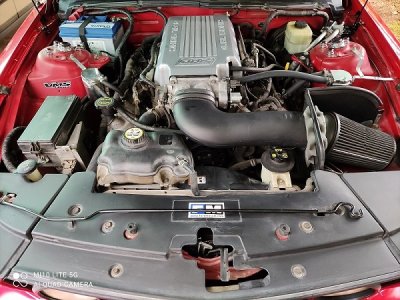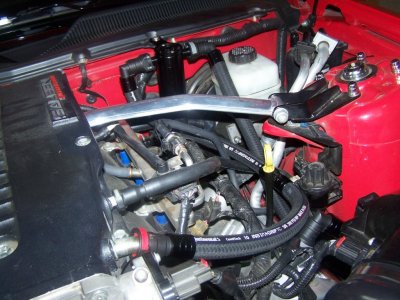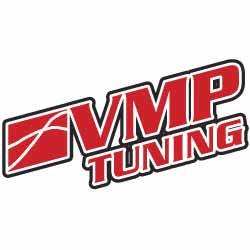The only concern that I would have with the additional check valve is oil condensing between the check valve and the pcv as any oil caught there may not drain back to the crankcase. As long as you clean it out and drain any residue in the line out regularly, it shouldn't hurt anything.Knowing that my PCV valve/meter is still intact inside the driver's side cam cover, is running an inline check valve between the cam cover and catch can providing any type of additional protection or would it be better to just not use an inline check valve at all while the PCV valve inside the driver's side cam cover tube is still active?
You are using an out of date browser. It may not display this or other websites correctly.
You should upgrade or use an alternative browser.
You should upgrade or use an alternative browser.
PCV valve?
- Thread starter dlanes
- Start date
Midlife Crises
Senior Member
Adding a second check valve inline with the factory PCV functional in the valve cover is redundant and has no benefit. It might even create a place for oily grunge to collect. Any manifold vacuum opens the PCV. Crank case pressure also opens the PCV so basically the PCV is open when the engine is running. I have never seen a 3 valve that did not have oil in the intake manifold. I totally understand why some people vent the engine with breathers and don’t use a PCV system, I just don’t like the oil mist that collects around the vents.
Dino Dino Bambino
I have a red car
Adding a second check valve inline with the factory PCV functional in the valve cover is redundant and has no benefit. It might even create a place for oily grunge to collect. Any manifold vacuum opens the PCV. Crank case pressure also opens the PCV so basically the PCV is open when the engine is running. I have never seen a 3 valve that did not have oil in the intake manifold. I totally understand why some people vent the engine with breathers and don’t use a PCV system, I just don’t like the oil mist that collects around the vents.
Agree, and that's why I have air oil separators on my car. The passenger side can stays completely dry but it does prevent oil vapours from contaminating my DIY ported throttle body. I empty the driver's side can at every 5000 mile oil change but since most of my driving is at low rpm, hardly anything collects in it. In case you're wondering, I have one stainless steel Scotch Brite spiral scrub in each can to trap the oil vapours. Notice I left some slack in the rubber pipe from the driver's side can to intake manifold to allow for engine movement.

GlassTop09
Senior Member
Agree w\ this in general....................Adding a second check valve inline with the factory PCV functional in the valve cover is redundant and has no benefit. It might even create a place for oily grunge to collect. Any manifold vacuum opens the PCV. Crank case pressure also opens the PCV so basically the PCV is open when the engine is running. I have never seen a 3 valve that did not have oil in the intake manifold. I totally understand why some people vent the engine with breathers and don’t use a PCV system, I just don’t like the oil mist that collects around the vents.
1.) An inline check valve won't get gunked up w\ oily grunge as there isn't any space inside it for free oil to drop out of the stream. I'm using the very UPR inline check valve linked in this thread in my Stang's PCV system for 17+ months (have gone thru 2 winters w\o issue) BUT I'm NOT using it to replace the existing PCV valve...am using it as an external PCV airflow volume control device (have a 1\8" orifice installed inside it along w\ the check valve's inner slider). Check out this thread if interested: Idle issues with lito tune..still :/ | Page 3 | S197 Mustang Forum - S197Forum.com pg #3 post #57 on.
2.) If you do remove the PCV valve completely then install this inline check valve to replace the PCV valve then intend to use the PCV system in it's OEM design (closed system) you're gonna find that you'll lose engine idle control due to excessive metered air flow essentially "bypassing the TB" thru the PCV system so then PCM can't control engine idle w\ TB.....
I would follow Jewc75's suggestion.....that GT500 PCV valve obviously has much tighter PCV air flow control being designed to operate w\ a TVS SC setup than the Coyote's part to prevent excessive PCV draw thru.
3.) If you want to help your 4.6L 3V to reduce\stop oil draw thru the closed PCV system, buy a set of the new improved oiling design cam followers & install them (these are the main reason why so much oil gets carried out the DS valve cover thru the internal PCV valve by the spraying of oil from the lash adjusters indiscriminately at the cam lobes causing a lot of oil to get sprayed\slung up into PCV air stream, get drawn into the PCV valve then out into IM). I did this last year for a different reason on my Stang (had 1 break on me so upgraded all of them) but the benefits are very real....I just swapped IM's on my Stang....the FPIM I pulled off had no free oil collected in it anywhere....none, nada, zilch....only had an oil sheen coating the inside walls. I do have a catch can installed as well but it doesn't have an oil level on it's dip stick so the can is empty....... I only mention this here due to this issue w\ 3V's was mentioned in this thread........
Hope this helps.
06 T-RED S/C GT
forum member
The only concern that I would have with the additional check valve is oil condensing between the check valve and the pcv as any oil caught there may not drain back to the crankcase. As long as you clean it out and drain any residue in the line out regularly, it shouldn't hurt anything.
You would think if oil may be condensing between the check valve and integrated PCV inside the cam cover, that very little to no oil would be going into the catch can? But what you bring up does make sense and I totally agree. My concern however, is how would I go about cleaning out the check valve and draining any residue in the line regularly being as the check valve is built-in/integrated into the hose? IIRC, I don't think the check valve can be removed from the line/hose


Adding a second check valve inline with the factory PCV functional in the valve cover is redundant and has no benefit. It might even create a place for oily grunge to collect. Any manifold vacuum opens the PCV. Crank case pressure also opens the PCV so basically the PCV is open when the engine is running. I have never seen a 3 valve that did not have oil in the intake manifold. I totally understand why some people vent the engine with breathers and don’t use a PCV system, I just don’t like the oil mist that collects around the vents.
So where exactly would the oily grunge collect? Note: the inline check valve is routed between the intake manifold and catch can, so I'm assuming the catch can is collecting most of the oily grunge while the inline check valve is preventing any residual oil from being sucked into the intake manifold

Agree, and that's why I have air oil separators on my car. The passenger side can stays completely dry but it does prevent oil vapours from contaminating my DIY ported throttle body. I empty the driver's side can at every 5000 mile oil change but since most of my driving is at low rpm, hardly anything collects in it. In case you're wondering, I have one stainless steel Scotch Brite spiral scrub in each can to trap the oil vapours. Notice I left some slack in the rubber pipe from the driver's side can to intake manifold to allow for engine movement.
View attachment 77417
How exactly is the passenger side catch can preventing any vapors from being sucked into the throttle body when the vapors are being draw into the intake manifold from the driver's side where the PCV is located? This is the reason your passenger side catch can always stays dry lol. It's the driver's side which vents crankcase pressure thru the PCV valve when open. The passenger side from my understanding only vents pressure from the crankcase when PCV/intake vacuum is closed from the driver's side. IIRC, intake vacuum only closes during WOT if I'm not mistaken

Last edited:
Okay, I made the ASSumption that the check valve was between the valve cover and the catch can, not between the catch can and the manifold. I don't see any harm having that check valve where you have it, it will encourage any oil in suspension to settle out and end up in the catch can.
Midlife Crises
Senior Member
A PCV is a check valve. It allows flow from the crankcase to the intake manifold and prevents flow from the intake manifold into the crankcase. Why would you need two of them in the same line. GlassTop09 is using a second “modified” valve as an orifice or variable orifice to control airflow. Not the same thing as just having two valves on the same line.
Yes, a check valve along with a functioning PCV is redundant
No, I wouldn't do it on my car
No, it won't hurt anything
No, I wouldn't do it on my car
No, it won't hurt anything
06 T-RED S/C GT
forum member
A PCV is a check valve. It allows flow from the crankcase to the intake manifold and prevents flow from the intake manifold into the crankcase. Why would you need two of them in the same line. GlassTop09 is using a second “modified” valve as an orifice or variable orifice to control airflow. Not the same thing as just having two valves on the same line.
For my particular application, the inline check valve is routed directly between the intake manifold and outlet side of the catch can. Where as the main PCV valve that's integrated inside of the driver's side cam cover is routed to the inlet side of the catch can. If I'm also not mistaken, as long as the inline check valve isn't being routed directly between the cam cover and catch can? the main PCV and inline check valves to my knowledge aren't being routed in the same line if I understand correctly? My main purpose for the inline check valve which is also one-way directional is to prevent any residual crankcase oil which the catch can doesn't always trap from getting sucked into the intake manifold

Last edited:
This is a thread in 2011+ 5.0 tech, 3v stuff doesn't apply here.
06 T-RED S/C GT
forum member
It does apply when the principles are related.
Actually it doesn't. Principles can be shared across a wide variety of cars but as has been pointed out the systems and parts are different therefore do not apply.
Midlife Crises
Senior Member
Sorry. Confused my systems. EGR reduces NOX. But the PVC still has little to no impact on performance and keeps things cleaner.

06 T-RED S/C GT
forum member
Out of the 5 others who have posted on this thread that btw: all own 3 valves, you appear to be the only one who has an issue concerning what and what does not apply. Despite the systems and parts being different between the 5.0 Coyote and 4.6L 3 valves, the PCV system pretty much functions in the same way and is therefore relevant according to the thread topic.Actually it doesn't. Principles can be shared across a wide variety of cars but as has been pointed out the systems and parts are different therefore do not apply.
However, If you would prefer that submitting up a new PCV valve thread in the 4.6L 3 valve sub-forums would be more applicable/relevant? That can certainly be arranged lol.
Last edited:
He asked a question about a coyote in a coyote tech section. Take your 3v tech to the proper section. K thanks
06 T-RED S/C GT
forum member
My 3v tech lol. There were also 5 other posters on this thread who are 3v owners. Perhaps you ought to read their posts as well. Otherwise, if you have such an issue regarding the posts as not being relevant to the thread topic? Report them!


All of the 3v tech needs to go in the appropriate section. I can report if thats what it takes. S197 was built on keeping tech in the proper section.
06 T-RED S/C GT
forum member
Is there any downside to removing the plastic PCV valve? I want to replace it with AN fittings for my catch can. This is how I currently have it:
View attachment 77393
As long as your replacing with an inline check valve? there is no downside to removing the plastic OEM PCV valve.
You could replace it with an inline check valve. I removed the PCV valve on my car as I am using breathers and have no tubes going back to the intake but if you are routing them back to the intake, you can use a check valve instead.
No idea what you'd need for a cracking pressure for the valve though.
From the images in his post, it appears the PCV system is still fully active connected to an oil separator/catch can. Unless his catch can is a breathable type? It doesn't appear he's running any type of an open, breather setup on his Coyote. Unless I somehow overlooked something? he just wants to replace his Coyote's cam cover and intake manifold ports with AN fittings just as his catch can has along with adding an inline check valve as a direct replacement for his Coyote's PCV valve, but yet would still function much in the very same way while also keeping the factory PCV system fully active.
Just run a GT500 pcv valve with the catch can and thank me later.
I want to replace it with AN fittings for my catch can.
I'm not removing the PCV system I am removing the stock valve. I am going to replace it with a check valve. (I think it is a flapper valve style). It should function almost the same as OEM.
This is a thread in 2011+ 5.0 tech, 3v stuff doesn't apply here.
The above post quotes address all the OP's questions and also directly apply to 2011+ 5.0 tech!
He asked a question about a coyote in a coyote tech section. Take your 3v tech to the proper section. K thanks
Once again! The OP's questions were addressed and directly related to 2011+ 5.0 tech in the proper section.
All of the 3v tech needs to go in the appropriate section. I can report if thats what it takes. S197 was built on keeping tech in the proper section.
Go ahead and report it.. Every post quote is in the proper section under 2011+ 5.0 tech.. Enough said!
Also just to recap, the OP has no interest in replacing his Coyote PCV valve with one from a GT500. He clearly stated his interest is to install A/N fittings on his valve covers and run an inline one-way check valve!
Last edited:
Quit the bickering
eighty6gt
forum member
- Joined
- May 9, 2011
- Posts
- 4,299
- Reaction score
- 405
Knowing what I do now, I would not screw around with a catch can system on any engine. Waste of money and time, adds weight.
Racing Vacuum Pumps from GZ Motorsports
Racing Vacuum Pumps from GZ Motorsports
Similar threads
- Replies
- 7
- Views
- 232
- Replies
- 3
- Views
- 142
- Replies
- 2
- Views
- 298
Support us!
Support Us - Become A Supporting Member Today!
Click Here For Details


